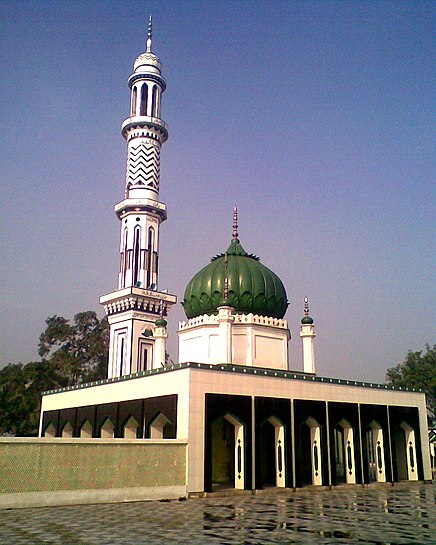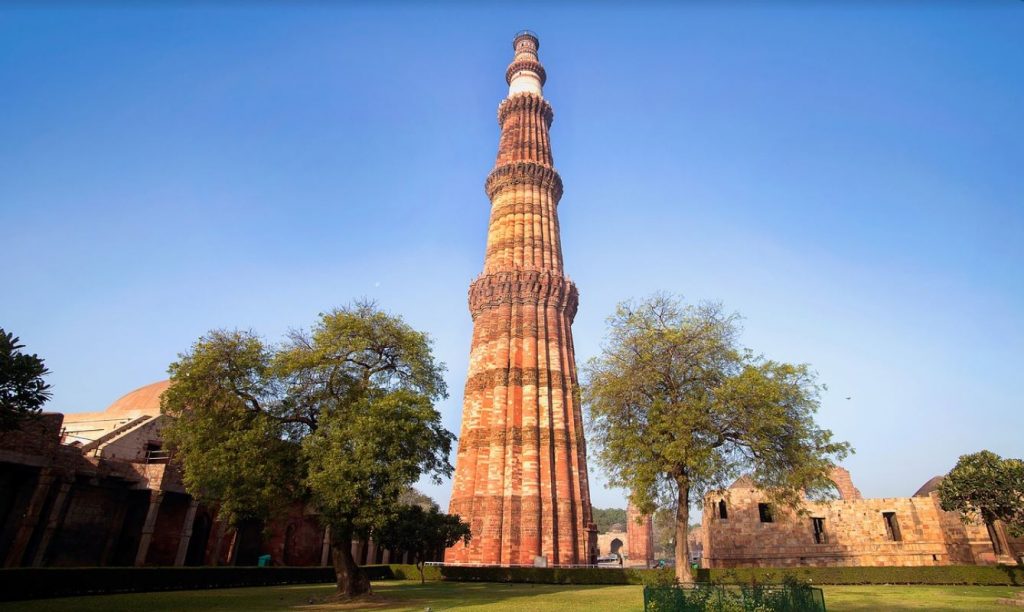Static Quiz 23 March 2024
Quiz-summary
0 of 5 questions completed
Questions:
- 1
- 2
- 3
- 4
- 5
Information
Static Quiz 23 March 2024 for UPSC Prelims
You have already completed the quiz before. Hence you can not start it again.
Quiz is loading...
You must sign in or sign up to start the quiz.
You have to finish following quiz, to start this quiz:
Results
0 of 5 questions answered correctly
Your time:
Time has elapsed
You have reached 0 of 0 points, (0)
Categories
- Not categorized 0%
- 1
- 2
- 3
- 4
- 5
- Answered
- Review
- Question 1 of 5
1. Question
Consider the following
1. Tughlaqabad Fort
2. Bada Gumbad in Lodhi Garden
3. Qutub Minar
4. Fatehpur SikriWhich one of the following is the correct chronological order of building the above monuments?
CorrectAns;- b) 3-1-2-4
Explanation;-
• The Qutub Minar- Built during the time of Qutubuddin Aibak ( 1206-1210).
• It was completed by Iltutmish. Built in memory of Sufi Saint Qutubuddin Bakhtiyar Kaki.
• The Tughlaqabad Fort- Built by Mohammed Bin Tughlaq (1320-25).
• He captured power from the last king of Khiji dynasty.
• The Bada Gumbad in Lodhi Garden- Bara Gumbad (literally “big dome”) is located in Lodhi Gardens in Delhi, India.
• It is part of a group of monuments that include a Friday mosque (Jama Masjid) and the “mehman khana” (guest house) of Sikandar Lodhi, the ruler of the Delhi Sultanate.
• The Bara Gumbad was constructed in 1490 CE, during the reign of the Lodhi dynasty.
• Its construction is generally attributed to Sikandar Lodhi.
• The Fathepur Sikri- Built by Akbar. Became the capital of Mughal Empire in 1571 by Emperor Akbar, serving this role from 1571 to 1585, when Akbar abandoned it due to a campaign in Punjab and was later completely abandoned in 1610.
 Incorrect
IncorrectAns;- b) 3-1-2-4
Explanation;-
• The Qutub Minar- Built during the time of Qutubuddin Aibak ( 1206-1210).
• It was completed by Iltutmish. Built in memory of Sufi Saint Qutubuddin Bakhtiyar Kaki.
• The Tughlaqabad Fort- Built by Mohammed Bin Tughlaq (1320-25).
• He captured power from the last king of Khiji dynasty.
• The Bada Gumbad in Lodhi Garden- Bara Gumbad (literally “big dome”) is located in Lodhi Gardens in Delhi, India.
• It is part of a group of monuments that include a Friday mosque (Jama Masjid) and the “mehman khana” (guest house) of Sikandar Lodhi, the ruler of the Delhi Sultanate.
• The Bara Gumbad was constructed in 1490 CE, during the reign of the Lodhi dynasty.
• Its construction is generally attributed to Sikandar Lodhi.
• The Fathepur Sikri- Built by Akbar. Became the capital of Mughal Empire in 1571 by Emperor Akbar, serving this role from 1571 to 1585, when Akbar abandoned it due to a campaign in Punjab and was later completely abandoned in 1610.

- Question 2 of 5
2. Question
Many new elements were added in Indian architecture during the Muslism rule. These include
1. use of shapes instead of natural forms.
2. use of calligraphy as inscriptional art.
3. use of trabeated roof.
Select the correct answer using the codes given below.CorrectAns;- a) 1 and 2 only
Explanation;-
• The Trabeated roof was used before the Muslims came.

• The Muslims added the feature of arcuate roof as reflected in the dome and double dome in their buildings.

• The tomb of Sikandar Lodi was the first example with a double dome, lifting its height in order to get a more attractive outward appearance.
• The Indian architecture took new shape with the advent of Islamic rule in India towards the end of the twelftth century AD.• The Islam introduced new elements into the Indian architecture including use of shapes (instead of natural forms), inscriptional art using decorative lettering or calligraphy, inlay decoration and use of colored marble, painted plaster and brightly colored glazed tiles.
IncorrectAns;- a) 1 and 2 only
Explanation;-
• The Trabeated roof was used before the Muslims came.

• The Muslims added the feature of arcuate roof as reflected in the dome and double dome in their buildings.

• The tomb of Sikandar Lodi was the first example with a double dome, lifting its height in order to get a more attractive outward appearance.
• The Indian architecture took new shape with the advent of Islamic rule in India towards the end of the twelftth century AD.• The Islam introduced new elements into the Indian architecture including use of shapes (instead of natural forms), inscriptional art using decorative lettering or calligraphy, inlay decoration and use of colored marble, painted plaster and brightly colored glazed tiles.
- Question 3 of 5
3. Question
Consider the following :
The arrival of Babur into India led to the
1. introduction of gunpowder
2. introduction of the arch and dome in the regions’ architecture
3. establishment of Timurid dynastySelect the correct answer using the code given below:
CorrectAns;- b) 3 only
Explanation;-
• The Gunpowder was introduced much earlier in the subcontinent, probably in the 13th century by Mongols.
• The Arch and dome architecture was widely prevalent during the Delhi Sultanate time much earlier than arrival of Babur, who established the Timurid dynasty in India in the 16th century.
 Incorrect
IncorrectAns;- b) 3 only
Explanation;-
• The Gunpowder was introduced much earlier in the subcontinent, probably in the 13th century by Mongols.
• The Arch and dome architecture was widely prevalent during the Delhi Sultanate time much earlier than arrival of Babur, who established the Timurid dynasty in India in the 16th century.

- Question 4 of 5
4. Question
What is the correct meaning of “Khanqah” during medieval period?
CorrectAns;- c) The place where Sufi Mystics lived
Explanation;-• A khanqah or khaniqah (also transliterated as khankahs , khaneqa, khanegah or khaneqah) is a building designed specifically for gatherings of a Sufi brotherhood or tariqa and is a place for spiritual retreat and character reformation.
• In the past, and to a lesser extent nowadays, they often served as hospices for saliks (Sufi travelers), Murids (initiates) and talibs (Islamic students).
• The Khanqahs are very often found adjoined to dargahs (shrines of Sufi saints), mosques and madrasas (Islamic schools). Incorrect
IncorrectAns;- c) The place where Sufi Mystics lived
Explanation;-• A khanqah or khaniqah (also transliterated as khankahs , khaneqa, khanegah or khaneqah) is a building designed specifically for gatherings of a Sufi brotherhood or tariqa and is a place for spiritual retreat and character reformation.
• In the past, and to a lesser extent nowadays, they often served as hospices for saliks (Sufi travelers), Murids (initiates) and talibs (Islamic students).
• The Khanqahs are very often found adjoined to dargahs (shrines of Sufi saints), mosques and madrasas (Islamic schools).
- Question 5 of 5
5. Question
The Qutub Minar was completed by the famous ruler
CorrectAns;- b) Iltutmish
Explanation;-
• The Qutab-ud-din Aibak started the construction of Qutub Minar in 1193.
• Its construction was completed by his son-in-law Iltutmish.
• The Qutab-ud-din Aibak, the first Muslim ruler of Delhi, commenced the construction of the Qutab Minar in 1200 AD, but could only finish the basement.
• His successor, Iltutmush, added three more storeys, and in 1368, Firoz Shah Tughlak constructed the fifth and the last storey. Incorrect
IncorrectAns;- b) Iltutmish
Explanation;-
• The Qutab-ud-din Aibak started the construction of Qutub Minar in 1193.
• Its construction was completed by his son-in-law Iltutmish.
• The Qutab-ud-din Aibak, the first Muslim ruler of Delhi, commenced the construction of the Qutab Minar in 1200 AD, but could only finish the basement.
• His successor, Iltutmush, added three more storeys, and in 1368, Firoz Shah Tughlak constructed the fifth and the last storey.













